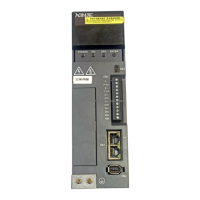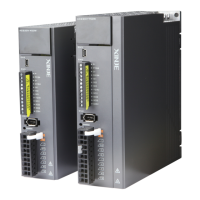To use the new homing function, first set P9-21=1, then set the overtravel switch (POT/NOT) and the
origin switch. If the mechanical offset (P9-19 and P9-20 are set), please set the offset within the travel
range to ensure that the mechanical equipment will not be damaged during the homing process!
The number of Z phases (P9-11.0) and the mechanical offset (P9-19, P9-20) can be valid at the same
time. If the number of Z phases (P9-11.0) and the mechanical offset (P9-19, P9-20) are not set to 0, the
servo will find the number of Z phases (P9-11.0) first, and then execute the mechanical offset (P9-19,
P9-20). If the number of Z phases (P9-11.0) is 0 and the mechanical offset (P9-19, P9-20) is not 0, the
servo does not find the Z phase, but executes the mechanical offset (P9-19, P9-20). If the number of Z
phases is not 0 but the mechanical offset is 0, the servo will find the Z phase (P9-11.0) without
performing the mechanical offset.
There are 8 homing modes in total, as follows:
(1) Positive homing, the deceleration point is the origin switch, and the origin is the origin switch or
motor Z signal (P9-11.2 = 0)
(2) Reverse homing, the deceleration point is the origin switch, and the origin is the origin switch or
motor Z signal (P9-11.2 = 1)
(3) Positive homing, the deceleration point and origin are motor Z signal (P9-11.2 = 2)
(4) Reverse homing, the deceleration point and origin are the motor Z signal (P9-11.2 = 3)
(5) Forward homing, the deceleration point is the forward overtravel switch, and the origin is the
forward overtravel switch or motor Z signal (P9-11.2 = 4)
(6) Reverse homing, the deceleration point is the reverse overtravel switch, and the origin is the reverse
overtravel switch or motor Z signal (P9-11.2 = 5)
(7) Positive homing, the deceleration point is the mechanical limit position, and the origin is the
mechanical limit position or motor Z signal (P9-11.2 = 6)
(8) Reverse homing, the deceleration point is the mechanical limit position, and the origin is the
mechanical limit position or motor Z signal (P9-11.2 = 7)
Each homing mode is analyzed in detail below:
1. Homing mode 0 —— Positive homing, the deceleration point is the origin switch, and the
origin is the origin switch or motor Z signal (P9-11.2 = 0)
To use this mode, you need to connect pot, not and origin switches.
(a) When the motor starts to move, the signal of the origin switch (deceleration point) is invalid (P5-64
= 0-invalid, 1-valid), and the forward overtravel switch (POT) (P5-22) is not triggered in the whole
process.
Firstly, the servo motor searches the deceleration point (origin) signal in the high-speed forward
direction with the set value of P9-12 (homing high speed) until it meets the rising edge of the
deceleration point (origin) signal. After gradually decelerating to -P9-13 (homing low speed) according
to the setting of P9-14 (homing acceleration and deceleration time), the servo motor searches the
deceleration point(origin) signal falling edge in the reverse direction at the low speed set by -P9-13
(homing low speed). When encountering the deceleration point (origin) signal falling edge, it will
reverse, and continue to search the deceleration point (origin) signal rising edge at low speed with
P9-13 (homing low speed). The next homing action can be divided into four cases:
(a1) Z phase number (P9-11.0) is 0 and mechanical offset (P9-19, P9-20) is 0:
During the operation of continuing to search the rising edge of deceleration point (origin) signal at low
speed with P9-13 (homing low speed), stop immediately when encountering the rising edge of
deceleration point (origin) signal.

